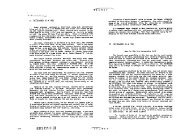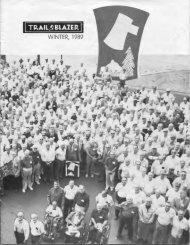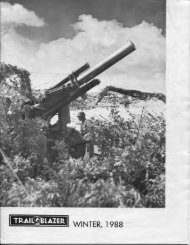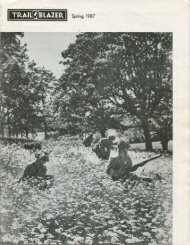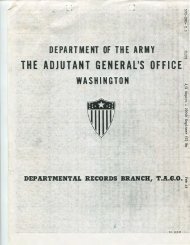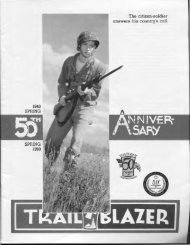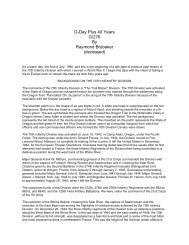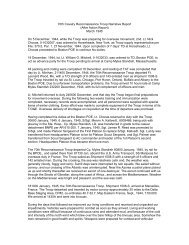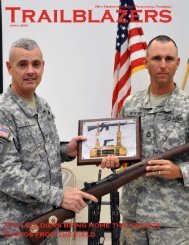70th Infantry Division Association January, 1986
70th Infantry Division Association January, 1986
70th Infantry Division Association January, 1986
You also want an ePaper? Increase the reach of your titles
YUMPU automatically turns print PDFs into web optimized ePapers that Google loves.
Attack!By Donald C. PenceThe <strong>70th</strong> at the Siegfried Line(")N THEIR POSITIONS the regi* * ments of the <strong>70th</strong> confronted a"-J series of unevenly wooded hillsdominating wide, uncovered draws. Anetwork of roads following the valleysconnected the many towns and villagesalong them with the industrial and miningcenters of Forbach, Stiring Wendel, andSaarbruecken-the southern gateway toGermany's Saar industrial basin and abastion in the Siegfried Line. A <strong>Division</strong>G-2 report described the enemy's defenses:"Multiple belts of entrenchmentsextend along the southern and southeasternslopes of the ridge system fromKleinwaldchen (woods) to Pfaffenwald(forests). Belts of anti-tank ditches andobstacles also extend in this zone. Secondarylines of entrenchments extend fromKerbach to Lixing, and along the SaarRiver through Kleinblittersdorf (oppositeGrosbliederstroff) to Saarbruecken. Ananti-tank ditch extends east from Alstingto the Saar. The Siegfried Line of permanentpillboxes extends along the southernoutskirts of Saarbruecken, then followsthe Saar River to the northwest."Immediately before the beginning of theXVth Corps offensive, Div. G-2 identifiedthe major enemy infantry components asthe 347th <strong>Infantry</strong> <strong>Division</strong> with three battalionsin the line and the 19th V olksGrenadier <strong>Division</strong> with two battalions inthe line. The enemy also had an estimated800 reserves in the Forbach- Stiring Wendelarea.In the overall scheme the <strong>Division</strong>'smission was to take the heights along theSaar River south and southwest of Saarbruecken.The plan called for seizure ofthe high ground extending due west fromSchoeneck and the larger, mostly wooded,range of hills running southeast from StiringWendel to Buebingen. The <strong>70th</strong> attackwas to be made with all three regiments online, the 276th on the left, the 274th in thecenter, and the 275th on the right.One minute after midnight, February17, the 276th, with the 3rd Battalion on theleft and the l st on the right, moved outthrough a heavy fog toward its initial objective:the hills between Oeting and Forbach.The main enemy positions ran west6from the southern edge of Forbach andsoutheast from there through Oeting to theheight Kelsberg. The 3rd Battalion advancedquickly through enemy small armsfire to take the height Fahrberg while thelst Battalion took Kelsberg. Key defensesat Oeting remained in enemy hands.The two battalions launched attackssimultaneously on Oeting from east andwest but were driven back by intensive firefrom self-propelled 88mm guns. Heavilymined roads forestalled the use of armor tosupport the attack, and the l st and 3rdbattalions withdrew to their two hills to digm.IN THE DIVISION CENTER the 2ndand 3rd battalions of the 274th hadcrossed the line of departure at 4:30a.m. on February 17. Their assignmentswere the clearing of Stiring Wendel andoccupation, with the 275th, of the heightssouth of the Saar. But there was an interveningseries of hills and towns to be takenbeforehand. The first objective was Kerbachand then the high ground to thenorthwest. Kerbach was entered, but theadvance stalled there when enemy tankscounterattacked from Etzling and Behren.Artillery support was summoned and theresponse beat back the enemy armor. By4:20 p.m. Kerbach and Behren werecleared.After moving through K Company in Behrenduring the predawn hours on the 17th, 1 Company,274th was moving in two columns alongThe basic account presented in this series isderived from the U.S. Seventh Army "Reportof Operations," and from <strong>70th</strong> <strong>Division</strong>general staff and smaller unit records. Thefirst installment, which appeared in the October'85"T roilblozer," covered the <strong>January</strong>and early February, 1945 reassemblingnear the Soar River of <strong>70th</strong> <strong>Division</strong> componentsafter a separation of over twomonths. Then the <strong>70th</strong>'s infantry regiments,organized as Task Force Herren, went to theETO ahead of the rest of the <strong>Division</strong> andfought during the German Nordwind offensive.It reviewed training to ready for combotthe Iorge number of infantry replacementsreceived during this time.a trail across an open field when it becamepinned down by machine-gun fire. From theadjacent woods came a voice shouting inbroken English: "Americans, Americans veevill giffyou 10 minutes to put down your armsand surrender; othervise you vill all die!"The ultimatum was repeated, but not a secondtime, after an I Co. rifleman fired a clipinto the woods. Still the company was stalledwhere it was behind the leading platoon, whichwas taking casualties from enemy shellfire, asit remained without initiative. Then 2nd Lt.Harold D. Wilson came up from the rear,began urging those around him to get going,and led the way into the woods. The advance,once started again, continued on to the objective,with Wilson occasionally calling out,"Let's keep going! Let's keep going!" evenafter being wounded by Panzerfaustfragmentsin the face and leg. Wilson was killed a coupleof weeks later.Following the Behren-Forbach road, LCompany, 274th moved forward on I Company'sleft, initially encountering no opposition,although there was firing all around it.Then it was taken under machine-gun fire .Hitting the dirt, the men waited, but not forlong. S/Sgt. Harold F. May crept and crawledforward until he got within range. Then hestarted tossing hand grenades, accounting fortwo Jerry machine guns. Then the Companygot moving again. He was awarded the SilverStar.First Lt. Fred Cassidy, Co. G, 274th, recallsthat its advance on the 17th left G Company outfront of the assault companies on its flanks. Ithad taken and held the key Wingertsknopfheight, north of the Behren-Kerbach road.Accordingly the Company's positions were deployedto defend the height in all directions ,and defensive artillery fires covering the approachfrom Etzling were prearranged. AttachedH Co . mortar and machine-gun sectionswere positioned to cover to the front while theG Co. weapons platoon protected the rear.The expected German attack, with tanks andinfantry, came at dusk and was allowed toapproach half way up the slope before theartillery TOT was called in and fire of allweapons on the ground was opened by thefiring of flare signals. The attackers weremoved down as they came on, taking heavycasualties. The next morning G Company wasstill on Wingertsknopf when F Company andthe 3rd Battalion came up on its flanks. (Note:in "Snow, Ridges and Pillboxes" the 274thcombat history, Wingertsknopf was given the<strong>70th</strong> <strong>Division</strong> Assn. TRAILBLAZER



